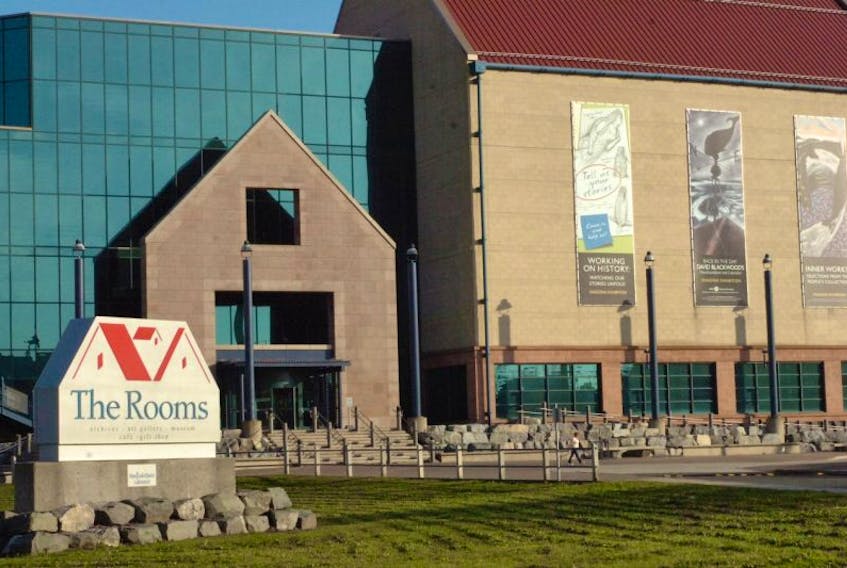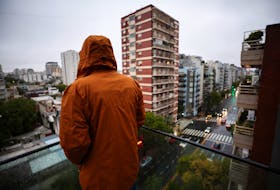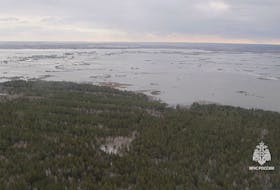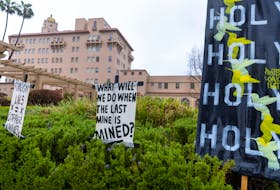ST. JOHN'S, N.L. — The Fort Townshend historical site may have slid off the public radar, but there’s still passionate interest among some to interpret the ruins, which remain protected by sandbags in the basement of The Rooms art, museum and archives complex.
As reported by The Telegram recently, it would take multimillions of dollars to interpret the grand battery wall and other features of the original Fort Townshend, which dates back to the late 1700s, as it remains the unfinished basement of the facility.
“Most of the people who championed the opposition (to The Rooms being built over the fort) have either passed away or retired or moved on. It’s largely forgotten in some ways,” said Barry Gaulton, a historical archeology professor at Memorial University.
Gaulton remembers well the sore spot that building The Rooms over the remnants struck with many archeologists and historians about 20 years ago.

Portions of the preserved 18th-century fortification were basically “destroyed to build another structure to celebrate our history and culture,” he said.
However, the fact the project was never completed is not the fault of The Rooms staff, who Gaulton said do a wonderful job in preserving and exhibiting history and culture.
“There’s no blame to be laid on anyone at The Rooms,” he said, acknowledging the lack of capital to finish the interpretive project, as well as the need for the political will to complete it.
The project of interpreting the grand battery remnants with a viewable archeology site — as once promised by a previous Liberal government — would need funding by an outside sponsor or sponsors because of its massive expected cost, as it isn’t possible with The Rooms’ annual budget.
“It’s definitely on our bucket list that we need to do, and we want to do if somebody out there has the funds to get this started,” Anne Chafe, The Rooms’ executive director of museums and galleries, told The Telegram for the recent article.
There are lessons to be learned as well as opportunities remaining, Gaulton said.
For one thing, he said the university could partner with The Rooms and the province on field schools associated with Fort Townshend.
“It’s a gem and an important part of our history,” Gaulton said.
The province could also learn a lesson regarding development on heritage sites and to never repeat what happened with The Rooms being built over remnants.
He also suggested a broader exhibit based on the thousands of artifacts unearthed during a dig in 2000.
In 2000, while archeologists conducted their dig at Fort Townshend, the public was invited in for tours of the site, which in the 1700s was vital to Britain's control of the Newfoundland fishery and was billed as among the largest such fortifications in the British North American defence network.
Lorraine Michael, who has just retired as an NDP MHA, was not yet in politics when she toured the archeological site back then.
She recalls marvelling at the portion of the fort’s walls that remained and her opposition to building The Rooms atop it.
“I was incensed by it,” she said. “I couldn’t believe it. The walls were pristine. … I stood there and said, ‘This is absolutely beautiful.’ … (Then-premier) Brian Tobin was determined to make this happen without delay. That’s how it seemed to me.

“It’s just abominable that people with expertise were not listened to.”
She said the then-Liberal government missed an opportunity of great potential, not just historically, but as a tourism draw.
She agreed the controversy is forgotten by many people, and acknowledged the project lags due to lack of money.
She suggested Tobin lead a committee to raise money to complete the project.
A few items, such as a teapot, plate and badges, are currently included in a small public display at The Rooms, but that’s a minor portion of the tens of thousands of artifacts uncovered prior to The Rooms’ construction — most of them found in bits and pieces.
When The Rooms opened, Level Zero (the fort site) and Level Four remained unfinished. Level Zero, though, has no ventilation system or environmental controls.
In a study by The Rooms, the interpretation of Fort Townshend fell low on the list, while other projects — Indigenous culture, the First World War exhibit sparked by the 100th anniversary of the Battle of Beaumont Hamel and more contemporary Newfoundland and Labrador history — were priorities when it comes to what outside benefactors wanted to fund.
The controversy surrounding the construction of The Rooms over the Fort Townshend site caused a major public stir in the early 2000s. A public interest group named the Friends of Fort Townshend was formed and there was a clamour to have the archives/museum/art gallery structure moved off the fort site before construction began.
In 2000, the then-Liberal government said it didn’t have the money to move the $40-million facility to preserve the site of the 18th-century British fort after spending several million dollars on site preparation work.
It was decided that the main level of the building would be raised off the ground by oversized concrete pillars and allow an active archeological site to operate once the building was complete. Features such as the battery wall and artillery barracks were sandbagged for protection.
But that viewable archeological interpretation is yet to be done, 14 years after The Rooms opened in 2005.
Twenty-six 18th- and 19th-century structures and/or features were uncovered and recorded by archeologists, according to the early news releases. More than 90,000 artifacts were conserved and catalogued and remain in The Rooms’ vaults.
Twitter: @BarbSweetTweets
RELATED









